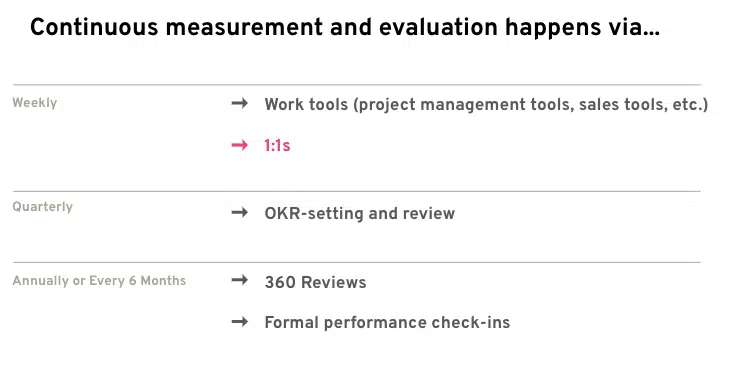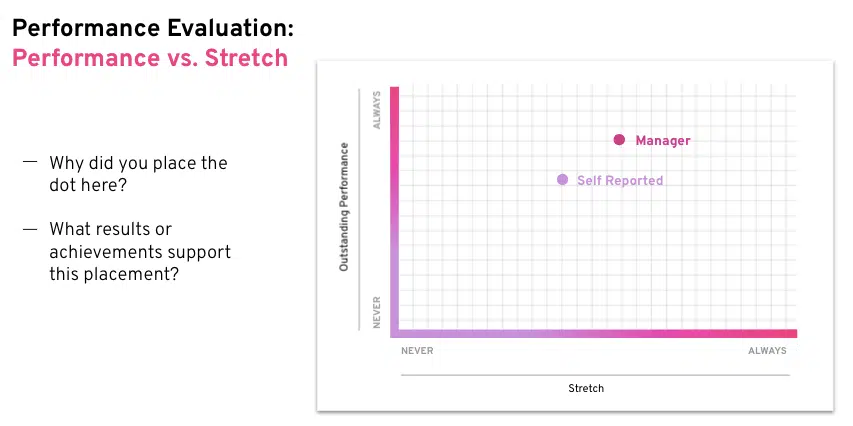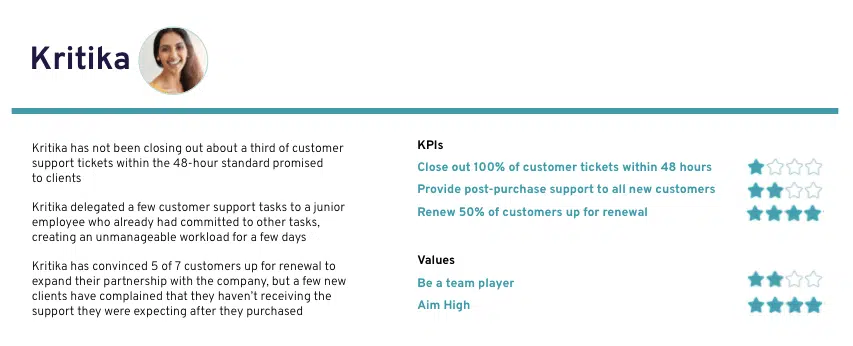When performance reviews and employee evaluations are executed incorrectly, they can do more harm than good. Reviews interrupt productivity, increase workplace anxiety and stress, and are an administrative and financial headache for your organization. In fact, Gallup estimates that, in order to take part in performance reviews, a 10,000 employee organization loses between $2.4 million to $35 million a year in lost working hours. And yet, only 14% of employees strongly agree their performance reviews inspire them to improve.
But when used correctly, annual performance reviews are a critical part of the employee experience. They give your employees valuable feedback that can be used to help them improve professionally and grow their careers with your company. And if your organization is spending the time, money, and effort to administer performance reviews, you’ll want to ensure you’re getting the most out of your investment.
In this guide, we’ll share why performance measurement matters, how it can help or hurt your business objectives, and how you can conduct a proper employee evaluation. Once your company has mastered the art of measuring, acting on, and evaluating performance, you’ll create an annual performance review process that motivates your employees to do their best work and propels your business forward.
The Importance of Performance Measurement
Measurement plays a bigger role in performance than you might imagine. While it’s important to have a metric-driven organization, over-emphasizing certain outputs, rather than impacts, can do more harm than good for your business.
For example, one of the top learning designers in the world, Julie Dirksen, was asked to design a training course for an insurance company. Employees responsible for upfront data entry were incorrectly entering some data points, which created issues for employees four or five steps down the line. Dirksen was asked to discover why.
When Dirksen asked how people were assessed and incentivized in the organization, she learned the business paid these employees based on how many applications per hour they entered, rather than the accuracy of their work. Dirksen determined that no matter what the company did, the accuracy of these reports would not improve until they updated their compensation strategy to motivate and reward employees for quality, not quantity.
As this example shows, if your business doesn’t measure the right things, you can inadvertently disincentivize valuable behaviors that comprise the performance you really want. That’s why you need to ensure your employee evaluations are not only fair and consistent but that they also reward the positive outcomes of your employees’ work.
How to Conduct an Employee Evaluation
So, how can you ensure you measure performance in a way that focuses on outcomes and impact? By conducting employee evaluations using goals and well-defined performance criteria.
First and foremost, key performance indicators (KPIs) and objectives and key results (OKRs) are effective ways to evaluate employee performance. Goals that are clear, ambitious, and aligned with larger organizational objectives allow managers and their employees to set productivity expectations and to better measure success.

But, as stated earlier, ineffective goals can adversely impact your business, so you need to ensure managers and employees work together to create effective and relevant goals. For example, say one of a Social Media Manager’s individual goals is to “Post 5 updates per day to our company’s social media page.” At first glance, this might seem like an acceptable goal. But while it is clear, attainable, and specific, it does not focus on the impact of these posts and can encourage speed over quality.
Posting five times per day does not mean the posts are good, engaging, or add value to your followers. In this case, a better KPI for our Social Media Manager might be to increase the business’ social media followers by X% this quarter. In this case, this outcome pushes the employee to not only focus on volume, but also quality.
It’s also important to call out that high performance can be recognized by more than just achieving KPIs and OKRs. The full impact an employee has on your workplace spans far beyond their productivity: it can include their attitude, willingness to help out colleagues, or even their involvement in an employee resource group (ERG). Here are some other dimensions of performance you might want to consider including and rewarding in your employee evaluations:
- Good habits
- Embodying company values
- Being an ally in the workplace
- Accomplishments
- Strengths
- Team contributions
Every organization is different, so your unique culture might value different employee characteristics than another business. In order to create a more holistic review process, before each review cycle, you should reflect on what other dimensions of employee performance you want to include in employee evaluations.
Acting on Performance Measurement
Once you’ve established what criteria your managers will use in your employee evaluations, it’s time for them to act on this measurement.
In practice, say one of your managers has a direct report named Kritika. Kritika leads the customer support processes for her team and during her first month in the role, her manager has noticed the following:
- Kritika has failed to close a third of her customer support tickets within the 48-hour standard promised to clients. In her last 1-on-1 meeting with her manager, she expressed concern that the 48-hour standard was too ambitious.
- Kritika delegated a few customer support tasks to a junior employee who already had committed to other tasks, creating an unmanageable workload for them.
- Kritika excels in customer relations and has convinced 5 of 7 customers up for renewal to expand their partnership with the company, but a few new clients have complained that they haven’t received the support they were expecting after they purchased your company’s product.
In this situation, if Kritika’s manager moved straight from the measurement to the evaluation stage of the performance review process without speaking directly to Kritika, their biases could color their evaluation in a potentially unfair way. Unfortunately, we don’t yet have the full picture of Kritika’s performance.
While it might initially seem like she’s underperforming, in reality, she may be closing out two-thirds of her tickets in a way that goes above and beyond for the customer, or she may have been given a large volume of high-touch tickets involving customers up for renewal that ate up the majority of her time. This is why it’s crucial managers never jump to conclusions, but rather have a conversation with their direct report to get the full picture of their performance and any challenges that might be holding them back.
While half of an annual performance review’s goal is meant to evaluate employee performance, the other half is to develop your employees. These conversations are a great opportunity for your managers to learn about their teams, help them grow, and better optimize workloads to allow employees to play to their strengths and develop their areas of improvement.
Here are a few examples of how Kritika’s manager could turn this conversation into a coaching and development moment:
- Help Kritika re-prioritize her work and identify high and low importance items so she can better organize her time
- Coach Kritika on how to better delegate work to others or how to more quickly close out customer support tickets
- Ask Kritika what obstacles she’s facing around supporting her clients and work with her to find the best path forward
- Work to her strengths and challenge her to take on more renewal tickets and convince more customers to renew their contracts
- You could rethink her role entirely and have her solely focus on renewing customers
These conversations should never be used to put an employee down or yell at them for poor performance. In fact, nothing your managers discuss in an annual performance review should be a surprise. They should have already discussed challenges, missed targets, and feedback with their employee in ongoing performance conversations, like weekly 1-on-1s or other casual syncs. Even so, performance reviews are an opportunity for managers to work with their direct reports to understand their perspective, find solutions to problems, and help them become better employees.
From Measurement to Employee Evaluation
After a few cycles of measurement and action, your managers will have learned enough about their direct reports to evaluate their performance. But we need to evaluate employees on more than just their manager’s impression of the work they do. Employee evaluations should be based on:
- Feedback from other coworkers
- How much they embody the company’s values
- The extent to which they help their team
- Times they went above and beyond their job description
- Their response to COVID-19 and other workplace challenges
Before your managers evaluate their teams, you’ll want to take a few extra steps to ensure your reviews remain fair and constructive for every one of your employees. If you have the time and resources, new and existing managers should attend training on how to give and receive feedback, as well as how to identify and overcome unconscious biases they might possess. At the very least, share these employee evaluation best practices with your people leaders:
- Stick to the facts – Ensure bias doesn’t skew your reviews by reminding managers to only evaluate their teams based on facts. Have them lean on KPIs/OKRs and peer feedback to objectively assess their team’s performance.
- Evaluate productivity across the whole period – This will help protect against recency bias and allow your managers to have a more holistic view of employee performance.
- Stay consistent for your entire team – Be mindful of affinity bias and how favoritism might impact employee ratings.
- Consider changes and challenges brought about by the pandemic – Approach performance discussions with empathy if you suspect employees are having a hard time.
- Incorporate 360-degree feedback – By combining self, peer, and manager reviews, your managers can get a more thorough understanding of an individual’s performance, as well as enable them to share more tactical feedback.
- Discuss performance in ongoing 1-on-1 meetings – If you’ve trained your managers to share feedback and coach their teams continuously throughout the year, your employees will be more open to hearing feedback and accepting of the outcomes – especially if nothing comes as a surprise!
If you’re looking to further remove biases in annual performance reviews, we recommend using
The Performance vs. Stretch Graph
The performance vs. stretch graph has employees and their managers plot themselves on a graph based on how well they think they are performing and how much they felt they had stretched themselves on the job. This helps managers and their employees understand where they agree and disagree on the topic of performance and can promote more in-depth coaching conversations as a result. Managers can objectively evaluate performance based on an individual’s KPIs and OKRs and stretch based on specific facts from 1-on-1 conversations, 360-degree evaluations, and other qualitative info to help guard against biases.

Of note: higher performers tend to undervalue their own performance, so managers can use any disparities in their ratings as an opportunity to highlight their direct report’s hard work and recognize their many contributions to the team.
The Star Approach
If you use star ratings or something similar, you can make them easier to swallow by giving ratings on multiple performance ingredients, being consistent across your team, and avoiding biases.

For example, let’s look back at Kritika’s performance. Rather than giving Kritika one performance rating, we may evaluate her performance on a scale of 1 to 4 stars across a few different aspects:
- Closing out 100% of customer tickets within 48 hours – Since Kritika only met this time frame on a third of her tickets, this is a clear instance of not meeting expectations. Her manager could award her 1 star in this area.
- Provide post-purchase support to all new customers – Since only a few customers have complained about Kritika’s service, her manager can give her the benefit of the doubt and say she’s mostly met expectations or achieved a rating of 2 stars.
- Renew 50% of customers up for renewal – She’s renewed 5 of 6 customers which far surpassed her goal, warranting her 4 stars.
- Be a team player – It seems Kritika is delegating work to others rather carelessly and overwhelming her teammates, so her manager might award her a 2 star rating on this front.
- Aim high – Because Kritika is not just renewing customers but convincing them to expand their business with the company, she is awarded 4 stars.
Here’s what her final employee evaluation might look like using the star method:

While ratings don’t have to be employee-facing, they can help your managers develop a more holistic view of their employee’s performance and justify the rating they gave them. Plus, your managers can then use these areas to better coach their employees as well as delegate and re-prioritize tasks.
An Argument for Continuous Performance Management
While annual or mid-year reviews are an essential part of assessing employee performance, your employees and managers need to discuss performance and share feedback more than once or two a year. In addition to traditional performance reviews, your business must also encourage continuous performance management conversations between your employees.
These conversations give your people leaders the opportunity to coach their teams as issues arise, rather than waiting months to share feedback in a formal review setting. Here’s a breakdown of what these conversations should cover, in case your managers need a bit of inspiration:
Not to mention, these ongoing performance discussions help to reduce some of the anxiety and stress associated with traditional reviews and employee evaluations. Plus, they provide more opportunities for planning, coaching, overcoming challenges, and creating psychological safety for your teams. Encourage your managers to connect with their employees frequently to share ongoing performance feedback and help their teams grow.
Train Your Managers Ahead of Review Season
Hone can help! Our live online learning classes teach your managers the skills they need to lead efficient and effective employee evaluation conversations, like Give Feedback That Lands, Manage Bias in the Workplace, Coaching, and more. Interested in trying Hone for yourself? Get a demo of Hone and try our classes for yourself.












